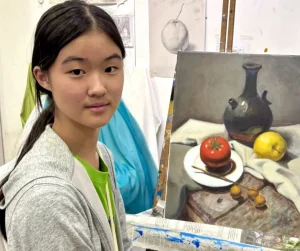Acrylic Painting on Canvas Team Bonding Art Jamming Singapore Visual Arts Centre

























Many people who enjoy Drawing and Painting are intimidated by the idea of drawing the human body. The human body has so many curves and lines, everyone’s body is different but at the same time proportions are so important, and just a little difference can make a body look wonky and off. While there are many different body types in the entire human race, each human body has a base anatomy structure and functionality that applies to all bodies. Most of us are no medical students but as artists we can learn to observe how joints move, how far a body part can move, when can a certain tendon be seen, how do muscle, fat and skin move, fold or wrinkle. Here are somethings about the human body you can learn during Nude Life.
The human body varies in shape and sizes but there are some base proportions that are relatively universal that will help you to construct a body that looks humanoid and functional. A simple example is how tall a human should be, when drawing an adult human, the general guideline used is 7-8 heads tall. Knowing proportions will help you to illustrate figures as you will know how to scale body parts relative to each other such as where the half-point of the body is or how the lower arm and hand are generally equal in length to the upper arm. Because we as humans spend our whole lives observing and seeing other humans, when we see a drawing of a human, it is easily recognisable to our eye if the proportions are wrong or unusual.

There are some tendons in our body that are only noticeable when stretched or pulled in a certain angle, some bones such as knuckles are also more prominent when the hand is in a fist for example. When you observe a live nude model posing, it is important to take note of when these tendons and bones are visible. Highlighting these parts of the body can help to give character and movement sense to your drawing, illustrating the tendons on a turned neck will show action and liveliness. Prominent knuckles can show the tightness of a clenched fist and portray the intensity of the subject’s emotions.

The body is made up of many different tissues that come in different textures that behave differently when stretched , pressed or squished together. Notice how a loose skin of a elderly’s hand wrinkles as compared to the chubby smooth fat hands of a baby that have big folds. Learning how to observe, place and shade these behaviours will help you define and characterise a body better and show the human qualities of your subject, a hand that is completely free of skin folds will appear to be synthetic and hard, whereas a hand that has has wrinkles at the joints and soft folds of muscle tissue and fat will look alive. Learning how different tissues behave will help people such as animators and character designers build figures, a fat person may have the same overall size as a muscular person however the areas of distribution and definition are completely different and identifying and knowing how to portray those qualities will help them to define the look and movement of a character.

Click and get to our WhatsApp
In the Batik Introduction Handkerchief Painting workshop, participants will learn the traditional art of batik, a wax-resist dyeing technique originating from Indonesia. The workshop begins with a brief history and overview of batik, highlighting its cultural significance and various techniques. Participants will then observe a demonstration of applying wax with tjanting tools and dyeing the fabric. Following the demonstration, each participant will design and create their own batik handkerchief, applying wax to create patterns and then dyeing their fabric. The workshop concludes with a group discussion, allowing participants to share their creations and reflect on their learning experience.